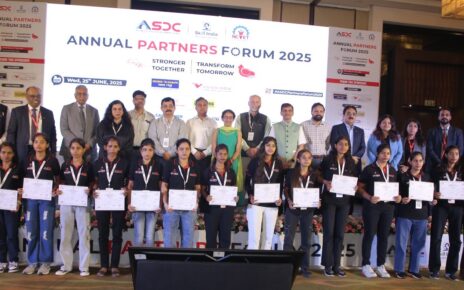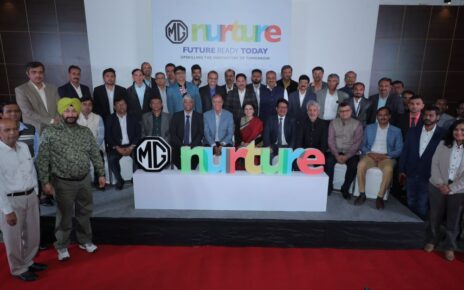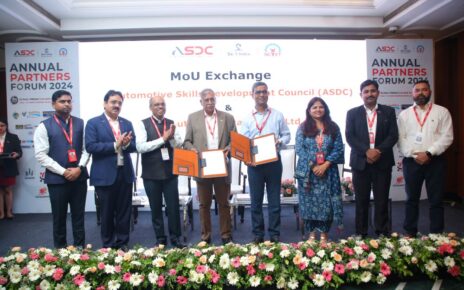
In this detailed account compiled by Rajesh Rajgor, insights from Vinkesh Gulati, Vice President of ASDC, highlight the Council’s pivotal role in shaping India’s future-ready automotive workforce. From empowering over 4,000 women through Project Saksham to forging high-tech alliances like BEST with Bajaj Auto, ASDC is aligning skilling with industry realities. Its international tie-up with Steinbeis University and partnerships with Indian HEIs are enabling global exposure and dual credentials. With 4.5 lakh learners and 2 lakh apprenticeships, ASDC is driving inclusion, innovation, and industry relevance across the skilling landscape.
As India’s automotive industry undergoes a transformative shift towards electric mobility, connected technologies, and sustainable solutions, the need for a skilled and future-ready workforce has emerged as a national priority. Leading the charge is the Automotive Skills Development Council (ASDC), which has been working quietly yet diligently to ensure that India’s automotive talent pool is not only competent but also inclusive and aligned with real-world industry needs.
“We are not just training people to get jobs—we are helping them build careers that evolve with the industry,” says Vinkesh Gulati, Vice President of ASDC.
Empowering Women Through Targeted Skilling Initiatives
ASDC’s momentum in FY 2024–25 is powered by a series of high-impact collaborations that are delivering tangible outcomes on the ground. Among these, its women-centric initiatives stand out for their scale, intent, and execution. Programs like Project Sakhi, Shakti, and Saksham are changing the very narrative around women in automotive roles. The Saksham Project, in partnership with Hero MotoCorp, has already trained more than 4,000 women as EV two-wheeler technicians. Impressively, over 50% of these participants have secured dealership roles, setting a new benchmark for gender inclusion in a historically male-dominated sector.

“Project Saksham isn’t just about skilling women—it’s about making them ‘saksham’ in the true sense: capable, confident, and industry-ready,” he affirms.
Looking ahead, the initiative plans to train 20,000 women over the next 15 months in roles ranging from service assistants to sales consultants. These programs are not only equipping women with technical capabilities but also building soft skills and workplace confidence, enabling financial independence and broader social upliftment.
Industry Integration and Global Outlook for Future-Ready Talent
ASDC’s impact extends far beyond women-centric programs. With over 4.5 lakh learners and 2 lakh apprenticeship contracts already completed, it has emerged as a key driver of skilled manpower in the mobility sector. Unlike traditional skill development models, ASDC has shifted the focus from sheer numbers to quality outcomes. Its deep collaboration with OEMs like Hero MotoCorp, Bajaj Auto, and Toyota enables it to co-create and regularly update curricula in alignment with emerging technologies.

“What sets us apart is our agility and our embeddedness within the industry. We are constantly listening, adapting, and evolving,” he says. “We don’t just certify—we ensure that every certified learner is job-ready.”
Initiatives like Apprenticeship Embedded Degree Programs and Recognition of Prior Learning (RPL) for informal sector workers ensure that skilling is holistic and inclusive, catering to both new entrants and existing professionals. The programs are mapped to the National Skills Qualification Framework (NSQF) and endorsed by industry leaders, making ASDC’s certifications highly credible and marketable.

This deep industry alignment is further exemplified by partnerships with major OEMs such as Bajaj Auto and Mahindra & Mahindra. The Bajaj Excellence in Skill Training (BEST) program, in particular, focuses on robotics and automation, preparing diploma and engineering students for high-tech automotive roles. With Volvo, ASDC has opened international placement pathways, making Indian talent globally relevant. “Our OEM partners do more than just fund training—they co-create content, host apprenticeships, validate our assessments, and train our trainers,” he shares. “It’s a complete ecosystem approach.”
This ecosystem is now expanding into more futuristic domains like electric mobility, mechatronics, and connected vehicles. ASDC is setting up dedicated Centers of Excellence, partnering with Tier 1 suppliers and startups, and creating hybrid learning models that blend online modules with hands-on workshops.
A critical part of ASDC’s strategy is its effort to integrate skill development with mainstream education. In FY 2024–25 alone, the Council signed 13 MoUs with Higher Education Institutions (HEIs) to launch short-term and apprenticeship-embedded courses. Through its tie-up with Steinbeis University in Germany, students can pursue a 1+1 Master’s program—studying in India for a year before completing their degree in Germany. This not only offers dual credentials but also includes internships in German automotive companies, thereby adding global exposure to their skillsets. “Our goal is to build globally competitive professionals who can work in India and abroad with equal ease,” Gulati explains.
On the domestic front, institutions like Sathyabama University, Sri Eshwar College of Engineering, and Galgotia University are actively participating in ASDC’s academic integration efforts. Moreover, the Council is running Trainer-of-Trainers programs to ensure that faculty across these institutions are up-to-date with the latest industry knowledge and pedagogical methods.
Igniting Young Minds and Bridging the Gap with Innovation Platforms
ASDC’s outreach also begins much earlier, at the school level. Through elective courses focused on electric vehicles, data science, and robotics, it is introducing young students to the world of mobility technologies. The National Automobile Olympiad (NAO), open to students from Class 6 to 12, gives participants hands-on experience and exposure to real-world automotive challenges. The grand finale of the Olympiad—featuring students from both India and Dubai—offers a glimpse into the future of automotive talent in the region. “Young minds are naturally curious. We just need to give them the right platforms to explore their potential,” says Gulati.
Beyond structured programs, ASDC is also leveraging job fairs, recruitment drives, and industry-led innovation challenges to create on-the-spot employment and learning opportunities. One such initiative was the BYD EV Innovate-a-thon, a collaborative event that encouraged youth and mid-career professionals to develop sustainable mobility solutions. These platforms help bridge the gap between industry requirements and talent availability, ensuring a robust pipeline for the next generation of automotive professionals.
At its core, ASDC’s mission is not just about skilling individuals—it’s about building a workforce that can lead the future of mobility in India and beyond. By integrating academia, industry, and global best practices, the Council is laying down a comprehensive roadmap that accommodates learners of all ages, backgrounds, and aspirations. “Inclusion, innovation, and industry relevance—these are the three pillars of our approach,” concludes Gulati. “We are not just preparing for the future—we are shaping it, one skilled professional at a time.”
As India speeds towards a greener, smarter automotive future, ASDC’s efforts serve as a crucial engine—driving inclusion, excellence, and transformation at every level of the skilling ecosystem.




